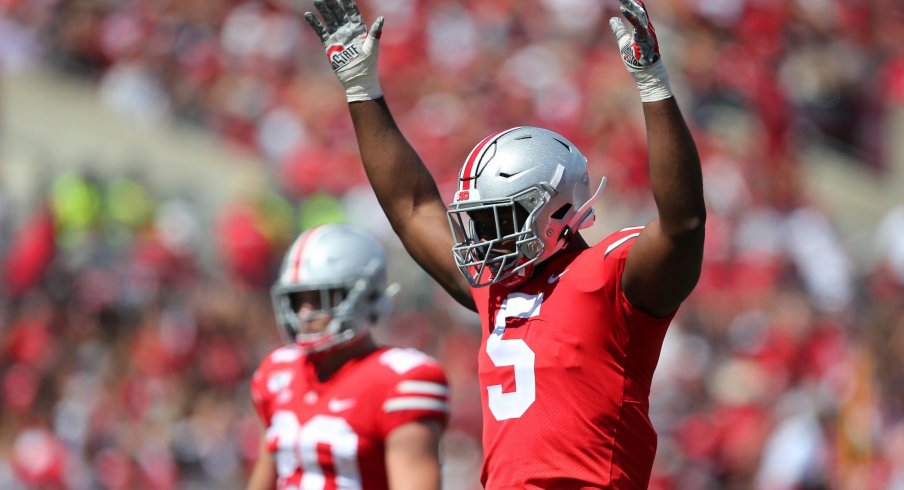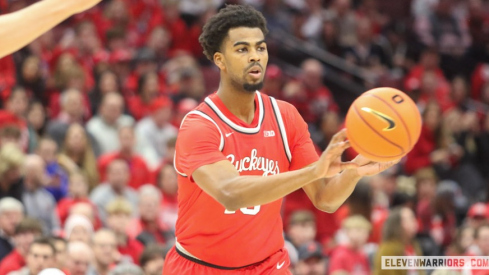"I think when guys know what they're doing, and they trust what they're doing, and they do it over and over and over again, they become confident in it." - Jeff Hafley
Coming into the 2019 season, it was clear to everyone involved that the Ohio State defense was in need of a revival. Through two games, the unit looks completely different.
Gone are the constant mistakes and missed tackles that led to long, explosive plays and in their place has come a dominant unit which rallies five or six defenders to the ball on every snap.
"I thought we owned the line of scrimmage today, did a great job. They were flying around," head coach Ryan Day said after his team shutout an opponent which beat UCLA the week prior. "That's what we envisioned when we put this together, we all got together I guess back in January when it all came about. But this is a great start for those guys. I thought they were running around tackling well and creating turnovers against a good Cincinnati team."
Though the Silver Bullets may appear similar on the surface, based largely on the fact that eight starters returned from a year ago, the schemes they're being asked to execute are quite different. After three seasons of relying on press man-to-man coverage, the unit has played a more conservative, 3-deep zone-match coverage instead.
With the exception of the free safety in the deep middle of the field, the rest of the back-seven are not running to defend a patch of grass as many of us were taught about zone defense in the old days. As Brent Venables of Clemson, one of the most respected defensive minds in the game, describes pattern match Cover-3 in his playbook:
"There are many benefits to matching routes after the pattern distribution. The first benefit is that it allows you to take the "air" out of the zones. The zones are no longer based upon areas of the field, but are now based upon the pattern distribution and the receivers' releases and spacing on the field. No longer are defenders "spot" dropping and covering areas of the field, but now are playing tight coverage on the receiver in their zone. By taking the "air" out of the zone, it now forces the QB to be more accurate and precise with his throws."
When opposing quarterbacks have looked downfield, they're still seeing receivers outside blanketed by Buckeye corners in what feels like man-coverage. However, the true benefit of such coverage is that all 11 defenders now have their eyes on the ball. No longer are defenders turning their head and losing track of where the play is going, as was often the case last season.
Without defenders trying to stay in the hip pocket of the receiver at all times, they can trade off responsibilities far more easily when needed, much like defenders switching a pick-and-roll on the basketball court.
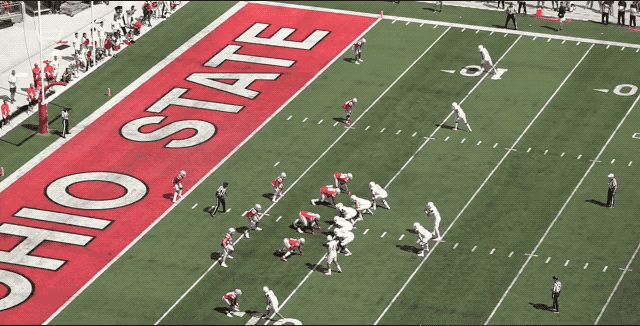
As with any coverage, there are trade-offs that come with this benefit. While quarterbacks must be accurate, especially downfield, there are weak spots that can be exploited in the system, particularly on short throws outside to the flats.
Both FAU and Cincinnati tried to exploit this weakness, and through two games, opponents are completing 61% of their passes against this Buckeye defense - up from 55% a year ago. However, opposing passer rating has gone down, from 122.24 to 110.40, as defensive backs like Jeff Okudah and Damon Arnette have excelled at flying to the ball and eliminating runs after the catch.

After promising to trot out a unit that would feature multiple alignments, coverages, and personnel groupings, co-coordinator Jeff Hafley admitted that through two games, his team hasn't deviated much from this Cover-3 look so far. However, in week 2 against the Bearcats, they executed a unique blitz package that few expected.
On a few early downs, the defense blitzed slot corner Shaun Wade through the D-gap to the strong-side, rotating free safety Jordan Fuller down into the role usually filled by Wade. As weak-side end Chase Young dropped in coverage to the flat, SAM linebacker Pete Werner was then asked to complete the rotation, bailing deep and occupying Fuller's spot as the centerfielder.
This full rotation allowed the defense to continue playing their 3-deep, 4-under coverage, but it gave the impression of an extra defender coming on a blitz, creating havoc throughout the afternoon. Though coordinator Greg Mattison used SAM linebackers Jabrill Peppers and Khaleke Hudson in the same role while at his former job in Ann Arbor, many were surprised to see the much-maligned Werner asked to rotate into a ball-hawking position.
"He's athletic, he's way more athletic than anybody gives him credit for," Hafley said of the junior linebacker. "So that gives us a little bit of a weapon, that he can move around and do things that you or other people don't think he can do. Pete's an athletic guy, so it's fun to have him out there, you can do different things."
While the decrease in pass efficiency is certainly welcomed, the true value of relying on Cover-3 is how easily it allows linebackers to shut down the running game. While the Owls and Bearcats attempted to run 67 times, the Buckeyes have allowed a measly 1.93 yards-per-carry, thanks in large part to the improved play of Werner and company.
After a quietly solid 2018 campaign, senior WILL linebacker Malik Harrison has been a star, making plays all over the field. With the athleticism of a small forward, Harrison is fast enough to track down runners from behind the play, even when not lined up properly.
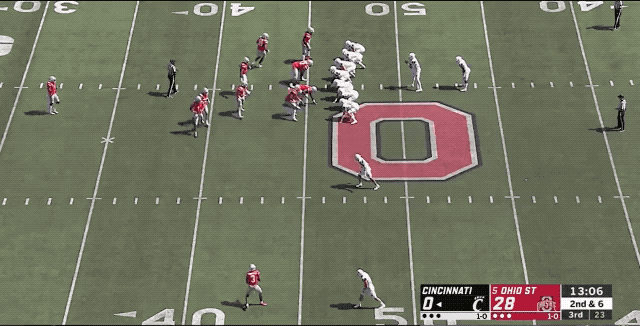
But he's also shown a nasty side, unafraid to meet blockers in the hole with a physicality not seen from a Buckeye linebacker since Raekwon McMillan left for the NFL.
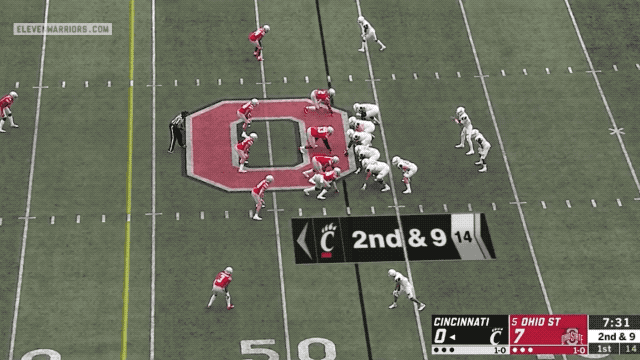
As the offense runs a zone-insert play (above), the tight end acts a lead-blocker for the running back through the B-gap to Harrison's side. But with his eyes directly in the backfield (and not worried about a receiver in man-coverage), Harrison fills the gap quickly, disrupting the path of not only the blocker but the back as well.
All four of the starting linebackers have been tasked with playing downhill in this manner, immediately stepping into their assigned "fits" at the first sign of a run. No longer is there a hesitation to wait and see what happens before reacting.
In this new system, junior middle linebacker Baron Browning has flourished. Rotating with Tuf Borland at that spot, Browning always seems to be around the ball, using the athleticism that earned him five stars as a recruit to shut down plays quickly.
"Baron's one of the smartest guys, as far as seeing things and catching things, he's as sharp a guy as I've ever been around," linebackers coach Al Washington said of the Texan.
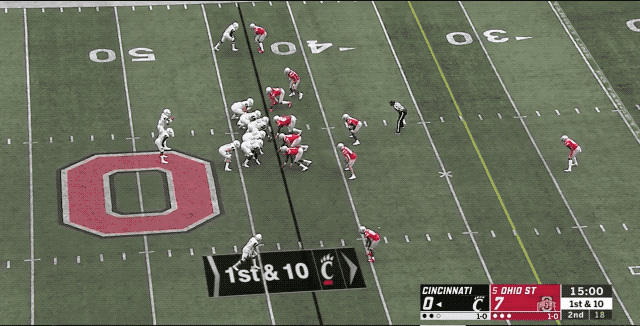
Though he's responsible for the opposite A-gap in the example above, he quickly diagnoses the pulling guard and tight end while also knowing that Harrison had blitzed to that side, leaving the edge unguarded. Instead of running straight ahead, Browning peels over the top, beating the runner to the edge and forcing a negative play.
As well as Browning played that, he wouldn't have been kept clean enough do so if not for the efforts of the linemen in front of him. While it was Robert Landers and Haskell Garrett who created penetration in that example, fellow tackles Davon Hamilton and Jashon Cornell have constantly blown up blocking schemes and kept Browning, Harrison, Borland, and Werner free to wrap up ball-carriers.
That same penetration has shown up on third downs as well. While Young may be the headliner of Larry Johnson's group up front, everyone seems capable of getting to the quarterback, especially when aided by Harrison or Browning on a blitz.

Though not credited with a sack, Hamilton has been nearly impossible to block in these situations, beating interior linemen and allowing Young to face only one blocker much of the time. The result is a stifling unit that has allowed only three conversions through the air in 31 third-down situations thus far.
Like on early downs, though, this production has come through the use of many base alignments, with few of the exotic blitzes one might expect from a former NFL coach like Hafley. That may be why the OSU secondary coach has credited the players with this turnaround rather than any play-calls from him or Mattison.
"I think our scheme is very sound. I think our D-line, and linebackers, and safeties, and corners tackled well again," Hafley said following the Cincinnati win. "Guys were in the right [run] fits. I think they were coached well all week by our staff...and our guys came to play. Our guys were tough today. They tackled today, and I think when we turn on the film, you're going to see it - our guys are playing with an edge right now, and it's going to be hard to block."
